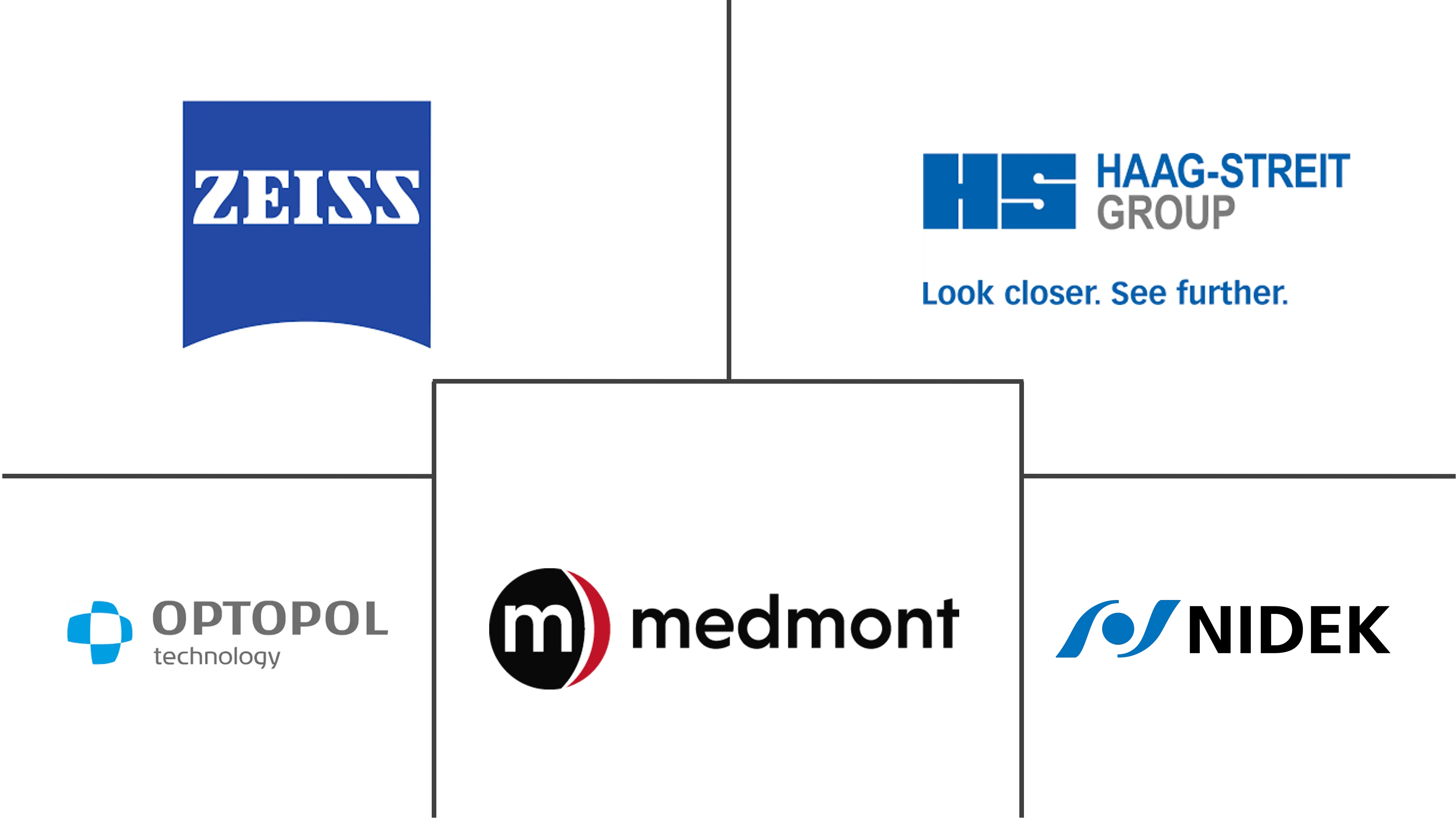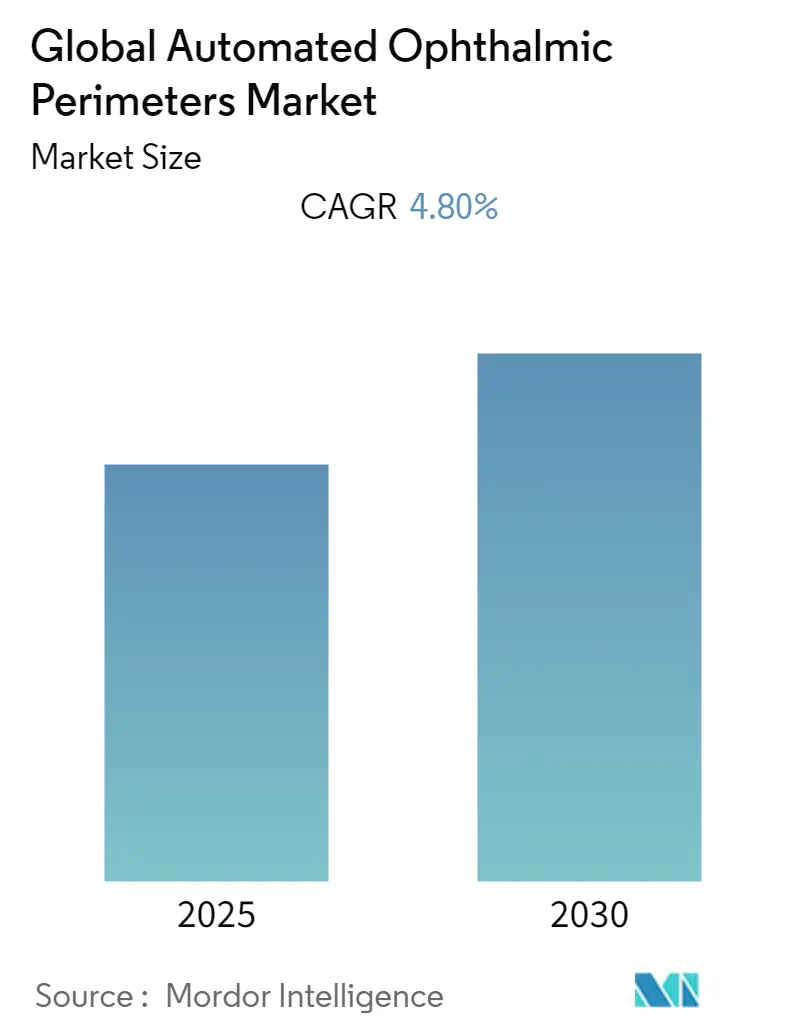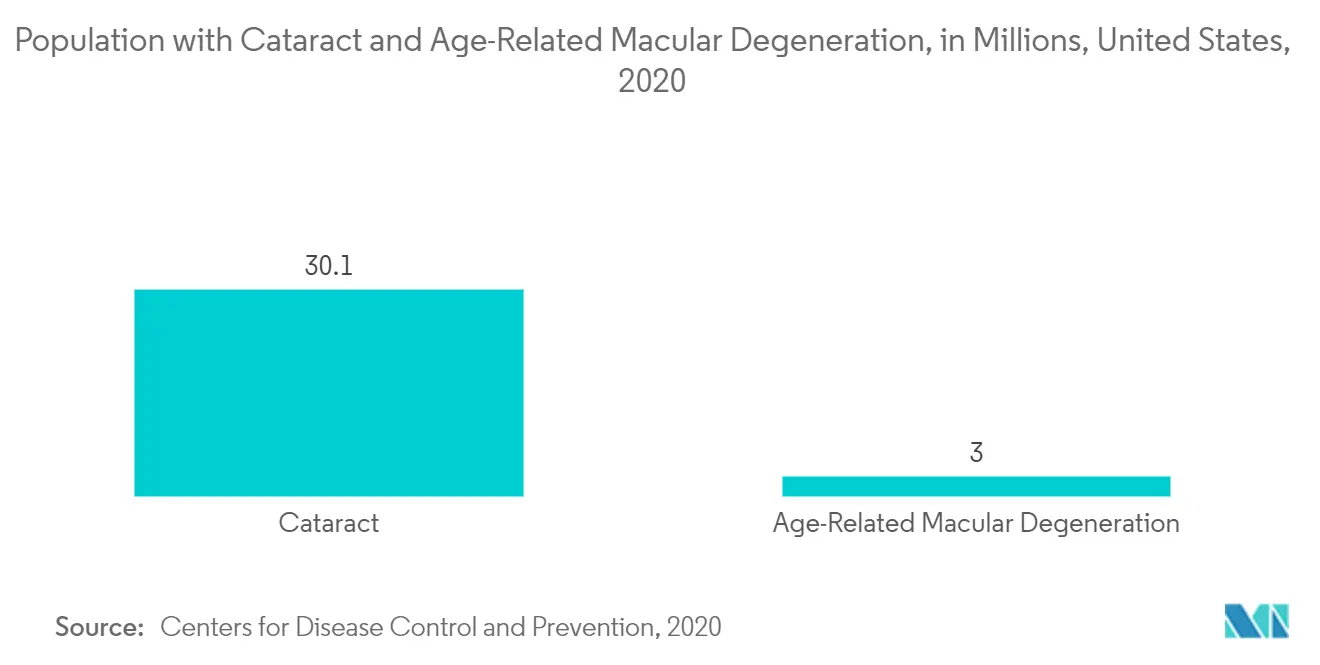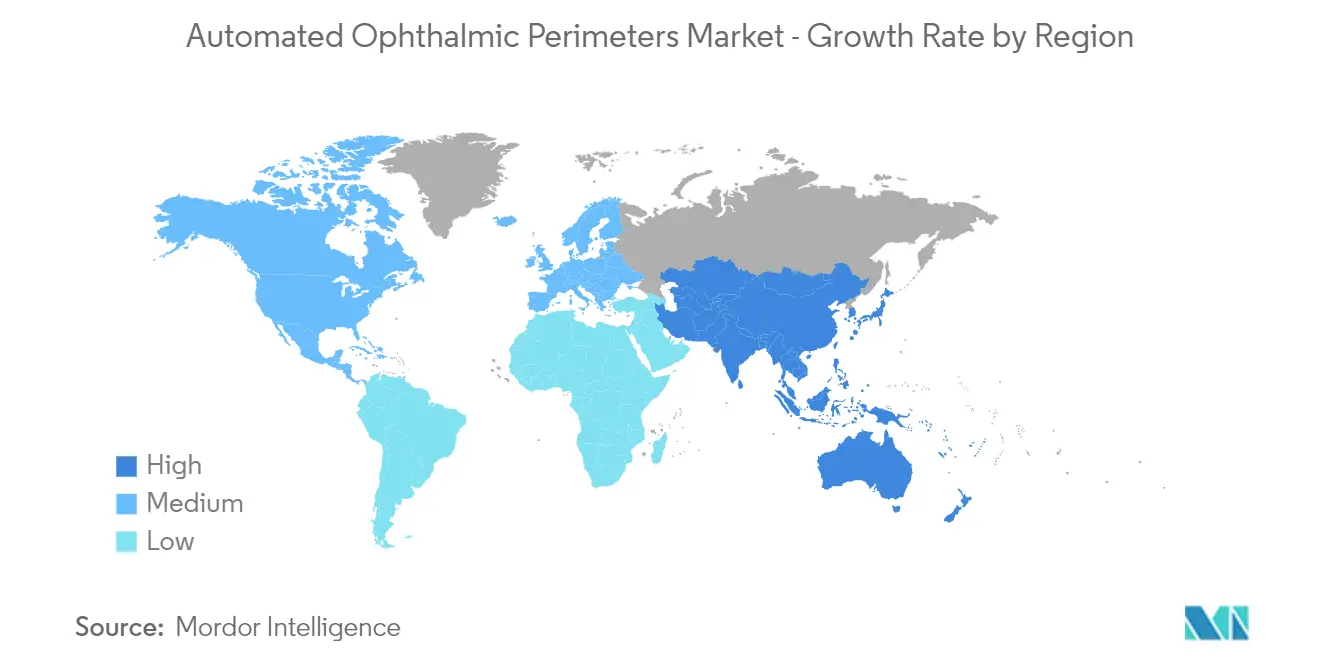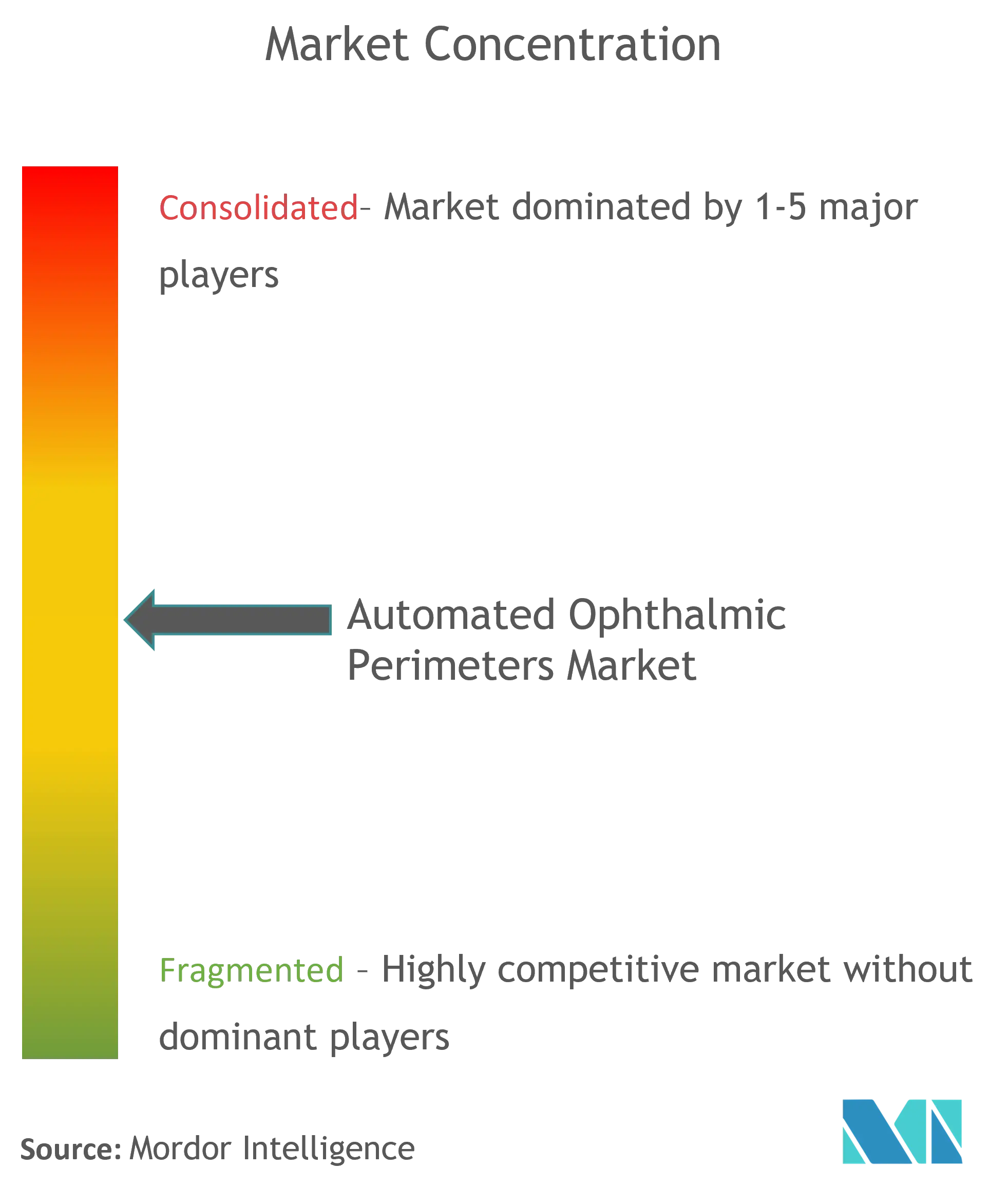Automated Ophthalmic Perimeters Market Analysis
The Global Automated Ophthalmic Perimeters Market is expected to register a CAGR of 4.8% during the forecast period.
COVID-19 related restrictions such as lockdown and restrictions on manufacturing activities have negatively impacted the market for automated ophthalmic perimeters. However, deteriorating vision quality due to prolonged mask use and a rising number of ophthalmic complications related to the pandemic are anticipated to boost the growth of the Automated Ophthalmic Perimeters Market. According to an article published by PubMed in 2021, the inappropriate wearing of face masks can cause visual field artifacts, which may be interpreted as low-test reliability or glaucoma progression.
The visual field can be impaired due to diverse diseases mostly by oculars such as retinitis pigmentosa, glaucoma, neurological disorders, and diabetic retinopathy. Ophthalmic perimeters are used in the diagnosis and detection of age-related macular degeneration, glaucoma, brain abnormalities, and scotomas. Automated perimetry offers several advantages over manual perimetry in that recording of patient responses as well as stimulus presentation can be standardized, leading to more reproducible results. Also, it delivers more sensitive and accurate findings in a timely manner, offers quantitative information, and early detection of glaucomatous damage is possible due to newer perimetric tests. This has increased the demand for automated ophthalmic perimeters in the industry.
The high prevalence of ophthalmic diseases is anticipated to drive the Automated Ophthalmic Perimeters Market over the forecast period. According to the World Health Organization in 2021, approximately 2.2 billion people have a near or distance vision impairment globally in 2020. Also, according to the World Health Organization estimation in 2021, approximately 76 and 195.6 million people were affected by glaucoma and age-related macular degeneration respectively in 2020.
Furthermore, the growing geriatric population is anticipated to propel the market over the forecast period. According to the World Population Ageing 2019 report published by United Nations, about 703 million people were aged 65 years or over in 2019 and projected to double (1.5 billion) by 2050. However, the scarcity of ophthalmologists, the high cost of automated ophthalmic perimeters, and increased competition and price pressure among major device manufacturers are likely to restrain the market growth over the forecast period.
Automated Ophthalmic Perimeters Market Trends
Static segment is Expected to Hold a Significant Share Over the Forecast Period
In static automated ophthalmic perimetry, stationary stimuli are presented at defined points in the visual field. Stimuli presented for longer durations of time may be seen better as a result of temporal summation of the information, though the limited additional benefit is derived beyond times over 1/10th of a second. The static automated ophthalmic perimeters are the most preferred devices for detecting glaucoma, assessing visual field quality, and monitoring glaucoma-related changes in the visual field.
Technological advancements in the industry are expected to drive the static automated ophthalmic perimeters segment over the forecast period. Technological advancements have increased accuracy in visual field testing and reduced turnaround time. The use of new software algorithms in the static automated ophthalmic perimeters is one of the major technological advances in the industry.
North America Dominates the Market and is Expected to do the Same in the Forecast Period
North America holds the major market share in the Automated Ophthalmic Perimeters Market and is expected to dominate the overall market, throughout the forecast period owing to the huge growth of the geriatric population along with the rise in the prevalence of ophthalmic disorders such as diabetic retinopathy, glaucoma, macular degeneration, and cataract in the region. According to the Centers for Disease Control and Prevention in 2021, about 30.1 million people were affected by cataracts in the United States in 2020. Additionally, as per data published by the Centers for Disease Control and Prevention in 2020, around 8.96 million Americans would suffer from uncorrectable vision impairment by 2050 due to the increasing epidemics of diabetes and other chronic diseases in the United States.
Furthermore, rapid adoption of new technologies, rising awareness, and high healthcare expenditure in the region are expected to boost the market share of the region in the industry.
Automated Ophthalmic Perimeters Industry Overview
The Automated Ophthalmic Perimeters Market is moderately competitive in nature with several players across the globe. Companies, like ZEISS International, HAAG-STREIT GROUP, Medmont, OPTOPOL Technology Sp. z o.o., NIDEK CO., LTD., OCULUS, Inc., Kowa American Corporation, MEDA Co., Ltd., Metrovision, and Heidelberg Engineering GmbH among others, hold the substantial market share in the market studied.
Automated Ophthalmic Perimeters Market Leaders
-
ZEISS International
-
HAAG-STREIT GROUP
-
Medmont
-
OPTOPOL Technology Sp. z o.o.
-
NIDEK CO., LTD.
- *Disclaimer: Major Players sorted in no particular order
Automated Ophthalmic Perimeters Market News
In July 2021, ZEISS introduced a fully integrated ecosystem where a combination of data management, devices, services, and applications will drive continuous improvement of patient outcomes. It would expand integrated workflow solutions at ZEISS.
In July 2020, Topcon Healthcare acquired the Henson line of perimeter business of United Kingdom-based Elektron Eye Technology. The Henson 9000 and 7000 perimeters were included in the acquisition agreement. The deal's terms were not disclosed.
Automated Ophthalmic Perimeters Industry Segmentation
Automated ophthalmic perimeters offer systematic measurement of the visual field and are an essential component of defining the extent and progression of glaucoma, as well as numerous other eye conditions. All automated ophthalmic perimeters measure sensitivity to certain stimuli at multiple locations in the visual field, though multiple variables define the perimeter. The Automated Ophthalmic Perimeters Market is segmented by Product (Static and Kinetic), End-user (Hospitals, Ophthalmic Clinics, and Others), and Geography (North America, Europe, Asia-Pacific, Middle East, and Africa, and South America). The market report also covers the estimated market sizes and trends for 17 different countries across major regions, globally. The report offers the value (in USD million) for the above segments.
| By Product | Static |
| Kinetic | |
| By End User | Hospital |
| Ophthalmic Clinics | |
| Others | |
| Geography | North America |
| Europe | |
| Asia-Pacific | |
| Middle East and Africa | |
| South America |
Automated Ophthalmic Perimeters Market Research FAQs
What is the current Global Automated Ophthalmic Perimeters Market size?
The Global Automated Ophthalmic Perimeters Market is projected to register a CAGR of 4.8% during the forecast period (2025-2030)
Who are the key players in Global Automated Ophthalmic Perimeters Market?
ZEISS International, HAAG-STREIT GROUP, Medmont, OPTOPOL Technology Sp. z o.o. and NIDEK CO., LTD. are the major companies operating in the Global Automated Ophthalmic Perimeters Market.
Which is the fastest growing region in Global Automated Ophthalmic Perimeters Market?
Asia-Pacific is estimated to grow at the highest CAGR over the forecast period (2025-2030).
Which region has the biggest share in Global Automated Ophthalmic Perimeters Market?
In 2025, the North America accounts for the largest market share in Global Automated Ophthalmic Perimeters Market.
What years does this Global Automated Ophthalmic Perimeters Market cover?
The report covers the Global Automated Ophthalmic Perimeters Market historical market size for years: 2019, 2020, 2021, 2022, 2023 and 2024. The report also forecasts the Global Automated Ophthalmic Perimeters Market size for years: 2025, 2026, 2027, 2028, 2029 and 2030.
Our Best Selling Reports
Global Automated Ophthalmic Perimeters Industry Report
Statistics for the 2025 Global Automated Ophthalmic Perimeters market share, size and revenue growth rate, created by Mordor Intelligence™ Industry Reports. Global Automated Ophthalmic Perimeters analysis includes a market forecast outlook for 2025 to 2030 and historical overview. Get a sample of this industry analysis as a free report PDF download.

